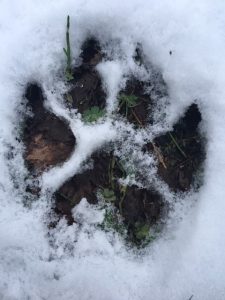This time of year in Portland we seem to be prone to ice storms, which are not  only an inconvenience to everyone, they pose a risk to dogs when de-icing products are used on slippery sidewalks and roads. The trouble is, even the products that say eco-safe or pet friendly may not be entirely safe for your pets to interact with.
only an inconvenience to everyone, they pose a risk to dogs when de-icing products are used on slippery sidewalks and roads. The trouble is, even the products that say eco-safe or pet friendly may not be entirely safe for your pets to interact with.
Here are some common ingredients and their concerns:
Salts (any ingredient that contains the word “Chloride”) are very important to avoid. Products like Earth Friendly brand of Ice Melt has magnesium chloride, a safer and less corrosive salt than the more common sodium chloride or potassium chloride, but any salts can be dangerous for pets to ingest, and can burn the skin on their paws, especially if it gets stuck in between their toes. Salt doesn’t just burn because it’s an irritant – it actually heats up when it comes in contact with moisture. You can check it out for yourself by putting a Tbs of salt and enough water to get it wet in a baggie – you’ll feel it heat up. It can get as hot as 170 degrees, and if that is salt that is wedged between their pads it can really burn. Then when they try to lick it off of their paws they’ll be ingesting it. Ingestion can cause gastrointestinal distress in small amounts and in larger amounts can cause hemorrhagic vomiting, diarrhea or death. Until recently, Portland hasn’t used salt on roads, but as of this winter, they have begun to use it on major roads here.
Calcium Salts (calcium carbonate, calcium chloride, and calcium magnesium acetate): are also very important to avoid. They cause similar problems to chlorides (above) – severe gastrointestinal distress is possible and local skin irritation.
Urea (carbonyl diamide) is a component of fertilizer. It’s found in products like Morton Safe-T-Pet and is a modified ingredient in Safe Paws. It is considered safe in a relative sense, but it can cause drooling and vomiting if ingested, and is damaging to waterways and to the animals that are found there. What we put on our sidewalks and roads runs off when everything melts and rejoins our rivers and streams. Pet Poison Hotline also notes that “large ingestions of urea may result in weakness, tremors, and methemoglobinemia”.
Acetates: Calcium magnesium acetate and potassium acetate are often praised for being less corrosive and damaging than salts, though recent research shows that potassium acetate, adopted by a majority of airports as a deicing agent, may damage aquatic life.
Ice Melters can also be damaging to concrete and plants:
Consumer Reports says, “Magnesium in any form (PDF), especially magnesium chloride, is very damaging to concrete, and concrete can become unstable after the corrosiveness in chloride-based ice melts eats away at the rebar. Similarly, acetate ice melts can cause asphalt pavements to strip easily, breaking the bond between the aggregate and the asphalt binder.
Never use an ice melt on concrete that’s less than 12 months old because newly poured concrete needs time to cure and settle. Applying an ice melt can weaken the concrete and make it more susceptible to future damage. Opt for sand or gravel to add traction.
Avoid spreading ice melt products around plants and getting it on your lawn. You can try to save plants or grass by soaking the affected area with 1-inch applications of water three to four times in the spring or replacing the soil in a small bed, according to Margaret Hagen, agricultural field specialist at the University of New Hampshire’s Cooperative Extension.”
Conclusion: We don’t believe there are any effective ice melting products that are free of risk for pets, but if you must use some, especially avoid the first two categories of ingredients above. Also consider, aren’t you just wanting better traction? Plain sand works very well for this! (cat litter can be messier after everything thaws, but would work perfectly well for traction in a pinch). At the store we remove all the ice/snow we can and sand the rest. Or, you can make your own de-icing mixture. Here’s a recipe:
Homemade Ice Melt
1/2 Gallon warm water
1 tsp. dish soap
1 Tbsp. rubbing alcohol
Mix it up and pour it on icy patches!
Important Safety Tips:
Don’t let your dogs lick areas that may be treated with an ice melting product or drink from puddles or slush pools when they’re outside. Even very limited amounts of 100 percent sodium chloride can be lethal to dogs, and your neighbors might be using those.
Immediately after a walk, rinse and dry your dog’s feet to remove chemical residues, and wipe down their bellies as well.
 Try booties – Boots are a great way to protect your dog’s feet. Check out PAWZ brand natural rubber dog boots. They are a great inexpensive way to protect their feet against contact with chemicals. They’re a pretty tough, biodegradable latex balloon-like material.
Try booties – Boots are a great way to protect your dog’s feet. Check out PAWZ brand natural rubber dog boots. They are a great inexpensive way to protect their feet against contact with chemicals. They’re a pretty tough, biodegradable latex balloon-like material.


